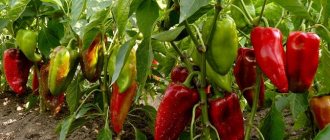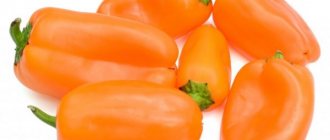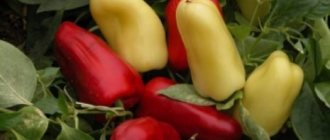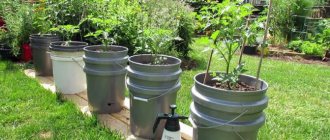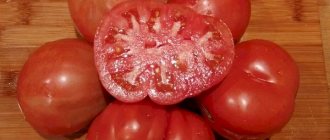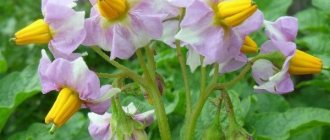The yield of sweet pepper mainly depends not on its variety, but on the climatic conditions of the area where it is grown. That is why for our latitudes it is recommended to choose domestically selected varieties that are already adapted to our unpredictable climate. One of the best varieties of sweet peppers for the middle zone is the Hercules variety.
Characteristics of the variety
| Options | Characteristic |
| Variety | Hercules (Gerakl) |
| Description of fruits | The peppers are large, with a uniformly colored glossy skin. |
| Pepper mass | 150-170 gr. |
| Color | Bright red when fully ripe |
| Form | Cuboid |
| Pepper size | Length up to 15 cm, width 11 cm |
| Wall thickness | 7-8 mm |
| Taste of the fruit | Sweet, rich aroma |
| Productivity | High |
| Maturation speed | 120-130 days after the appearance of the first shoots |
| Bush height | 70-80 cm, needs a garter |
| Pollination type | Self-pollinating |
| Nestedness | 3-4 slots |
| Type of ovary formation | Single |
| Transportability and keeping quality | Suitable for long-term storage and long-distance transportation |
| Resistance to adverse conditions | Tolerates temperature drop well |
| Resistance to diseases and pests | High, not subject to tobacco mosaic |
| Should I dive? | If the plant is planted in one seedling container |
| Recommended growing regions | Universal variety suitable for all regions |
| Year of inclusion in the State Register of the Russian Federation | 2007 |
| Originator | Federal Scientific Center for Vegetable Growing |
Advantages and disadvantages
Sweet bell pepper Hercules has many advantages, among which are the following:
- Large-fruited.
- Fleshy pulp with a sweet taste without bitterness.
- Versatility of use.
- High yield.
- Resistance to crop diseases.
- Transportability.
- Long shelf life.
- Resistance to adverse weather conditions.
Among so many positive qualities, no shortcomings were identified in this variety.
Description of the variety
Before growing a crop on a plot, you must carefully study the description of the variety. The plant is tall. The height of the bush can reach 70-80 cm, slightly spreading. The leaves are small, rich green in color with a medium degree of wrinkles.
Cube-shaped peppers are yellow-green during growth. However, once fully ripe, they become a rich red color. The taste is pleasant, sweet. It is also worth noting the rich aroma of pepper, which persists even after long-term storage of the crop.
The variety has good yield. Peppers can be harvested in late August early September. The average fruit weight is 150-170 grams, ripening time is 120-130 days. The peppers are evenly colored and are ideal for long-term transportation.
Typical diseases and pests
Diseases and pests appear due to sudden climate changes, heat or rain, and improper care.
The most common and dangerous diseases are:
- Late blight is a fungal infection that occurs due to high humidity and heat. To prevent late blight, follow the rules of crop rotation, loosen the soil in a timely manner, and remove weeds. The fungus appears in the form of yellow and brown spots on the leaves, the fruits lose their elasticity and taste. The disease is treated with Quadris or Oksikhom.
- Powdery mildew is a virus that appears as a white coating on leaves and stems. Occurs due to contaminated soil, excessive application of mineral and organic fertilizers. For prevention, spraying with iodine or a solution of copper sulfate is used, for treatment - a solution of wood ash or “CHOM”.
Among the pests, wireworms, mole crickets and Colorado potato beetles are noted. Insects live underground and are frost-resistant. They destroy plants from the roots: they gnaw them, which is why the stem does not receive nutrients. Dry eggshells will prevent the appearance of pests: they are scattered over the beds. To get rid of insects, use “Typhoon” or “Hurricane” products.
Pros and cons of the variety
| Advantages | Flaws |
| The fruits are large | High demands on soil conditions |
| Sweet taste, rich aroma | Not suitable for whole preservation |
| Universal purpose | Not resistant to pests |
| Suitable for long-term storage | |
| Suitable for growing in all regions | |
| Tolerates sudden drops in temperature well | |
| Is immune to disease |
Planting seeds
Hercules is grown by seedlings. It is best to plant seeds in March. All planting material is soaked in a weak solution of manganese and kept there for about fifteen minutes. The seeds are dried and sown in containers filled with fertilized soil mixture. For sowing, it is recommended to use cassettes or peat pots.
Conditions for growing seedlings
To create a greenhouse effect, the containers must be covered with cellophane or a piece of glass so that the seeds begin to germinate as quickly as possible. The soil is moistened from time to time.
As soon as the first shoots appear, mineral supplements can be applied. Young seedlings are transferred to a cooler room, hardening begins a couple of weeks before transplanting into unprotected soil.
frame class=”lazy lazy-hidden” title=”28. A time-tested method for growing tomato and pepper seedlings.
Tips for growing the Hercules variety
Gardeners are recommended to grow Hercules pepper through seedlings. Caring for the crop is not difficult, but for a large harvest you need to use regular fertilizing and thoroughly moisten the soil. The culture is suitable for growing in a greenhouse or open ground.
In order for the plant to grow quickly, it is necessary to regularly loosen the soil and use mulch. A layer of mulch protects the bushes from drying out and preserves the integrity of the peppers after full ripening.
When to sow Hercules pepper seedlings
Sowing seeds for seedlings must be done from late February to mid-March. For the southern regions, planting takes place in February. For northern and Moscow regions, seed planting is carried out in March.
How many days does it take for Hercules pepper seeds to germinate?
When planting seeds for seedlings, they must first be soaked in warm water or a light solution of potassium permanganate. You need to sow the seeds after they hatch. After preparing the planting material, seedlings will appear in 6-7 days. Without pre-treatment, seeds sprout only after 10-12 days.
When and at what distance to plant Hercules pepper in the ground
When planting, the distance between the bushes should be at least 25-30 cm. For open ground, planting should be carried out no earlier than the end of May. For warm regions, seedlings can be planted in mid-May.
Ripening period
The ripening period for peppers is 120-130 days after germination. Green fruits can be collected for consumption. However, for long-term storage, bright red peppers need to be collected from the bush. On average, the most suitable period is mid-September.
Watering
One of the agrotechnical care measures is watering. The Hercules pepper in the greenhouse needs to be watered every 3-5 days. Drip irrigation can be used. For plants in open ground, watering is carried out after the top layer of soil has dried. Moisture needs to be added every 2-3 days. At least 1 liter of water is used for one bush.
Before watering, the beds must be thoroughly loosened. For irrigation, warm water is used, which has previously settled. In order to retain moisture, you can use a layer of mulch. For pepper, it is recommended to use sawdust mixed with humus.
What and when to feed
Fertilizing is necessary to obtain a large harvest. To ensure that the plant does not lack nutrients, you need to apply fertilizer according to the following scheme:
- During the period of seedling growth, nitrogen fertilizers, for example, urea, are used. This feeding allows you to enhance the growth of seedlings;
- the second feeding is carried out before the start of bud formation. Potash fertilizers are used for such purposes;
- The last fertilizing is carried out using potassium-phosphorus fertilizers.
If the soil is poor, you can use complex fertilizers. However, the frequency of feeding should be no more than once every 2 weeks.
Is it necessary to pick Hercules pepper?
Picking for seedlings is necessary if the seeds are planted in one planting container. In order not to dive, the seeds should be sown in separate cups. It is necessary to pick the plants only after the true third leaf appears.
The bushes have well-developed lateral shoots. Therefore, you need to plant the plant in the ground at a distance of 25-30 cm. To obtain a large harvest, you need to carry out pinching. To form a bush, you need to trim the side shoots, this will increase the size of the peppers.
Diseases and pests
Among the most common diseases that can occur on bushes is blossom end rot. The disease appears as a dark spot that causes the fruit to dry out. In order to avoid such problems, you need to treat the bushes with calcium nitrate.
Another problem that can arise in garden beds is pests. Among the most common pests of peppers are aphids and spider mites. Small insects feed on the sap of the plant and cause it to dry out in a short time. To combat pests, you need to treat the bushes with Strobi and Aktara.
Growing and care
Peppers need light and nutritious loose soil. Since the fall, the land has been treated with Bazudin or irrigated with Fitosporin to prevent infection. To heat the beds, you can cover them with fiber or black film. Fertilizers per 1 m2 include:
- 30 g superphosphate;
- 1 bucket of compost;
- 20 g potassium sulfate;
- 1 cup of ash powder.
The holes are dug at a distance of 30 cm, leaving a row spacing of 50 cm. The depth of the hole is 15-20 cm. Peppers are planted together with peat pots, without deepening the seedlings below the root collar. To make the bushes comfortable in greenhouses and under film, they monitor the regime - humidity at 60-65%, temperature 23-27 degrees.
The peppers are not watered for the first 6-8 days, then the frequency is set to 1-2 times a week. From the moment of ripening and at the height of the heat, the beds are moistened up to 2-3 times a week. Use settled water. Avoid contact with leaves and stems, soak the soil to a depth of 10-14 cm.
Before irrigation, check the soil moisture; it should dry out by 4-5 cm.
Mulching to retain moisture has a good effect. They use straw, hay, compost, and rotted sawdust. A layer of 7-8 cm is applied.
Pepper Hercules F1 needs 3-4 feedings per season. Fertilizers are applied 10 days after transplantation, at the budding stage and during ripening. They use organic matter (herbal teas, diluted mullein or dung), mineral compounds, complexes (Ideal, Agricola, Fertika, Dobrivo, Clean Sheet).
The formation is carried out in 2 stems, like the letter U.
Analogs
| Analogue | Characteristics similar to the Hercules variety |
| California miracle | The fruits are large, sweet with a pleasant aroma. The bushes are tall, and with proper care you can reap a large harvest. |
| Claudio | The bush can reach a height of up to 1 meter, the fruits are large and rich red in color. The crop ripens 115-120 days after emergence. Suitable for long-term storage, has a pleasant taste and bright aroma |
| Bagheera | The high-yielding variety has the shape of cubes and belongs to the average ripening period. The color of the fruit is rich red with a slight purple tint. |
| Eastern Star F1 | The variety is classified as mid-season. Despite the fact that the bushes are small, large fruits can be collected. The color of the peppers is bright red. The taste is pleasant sweet with a rich aroma. |
Features and benefits of culture
Among other features of this variety, it is worth noting its rather large size. The average weight of these vegetables is 200-300 g. As for the length of the peppers, it ranges from 10 to 12 cm. The width of the vegetables is usually 11 cm.
Another attractive feature for gardeners is the high yield. If you care for vegetables correctly, then from 1 sq. m. you can remove from 2 to 3.5 kg of vegetables.
Among the advantages of this variety, it is worth noting its large fruit, versatility, good transportability, consistently high yield, excellent taste, and excellent keeping quality. In addition, the plant is highly resistant to many common diseases characteristic of these vegetable crops. The “Hercules” variety is not afraid of tobacco mosaic, which is common among peppers.
Attention! The plant can be cultivated even in regions with unfavorable climatic conditions. The variety is also resistant to the vagaries of weather.
From 1 sq.m. you can collect up to 4 kg of peppers

